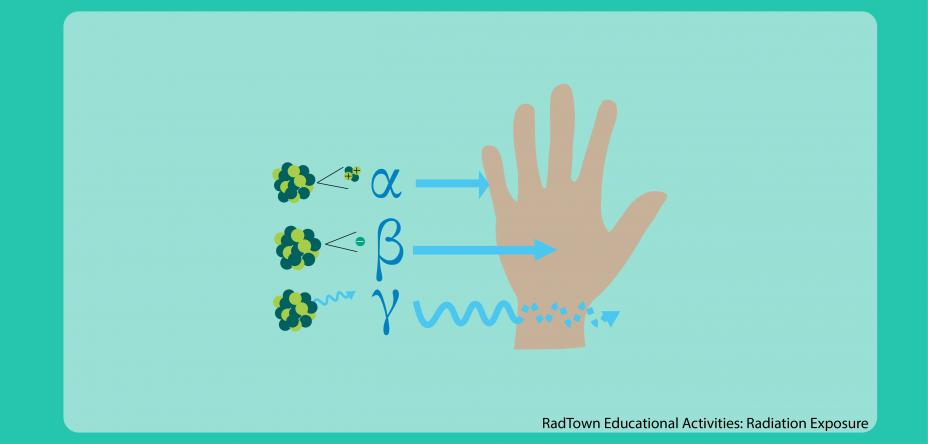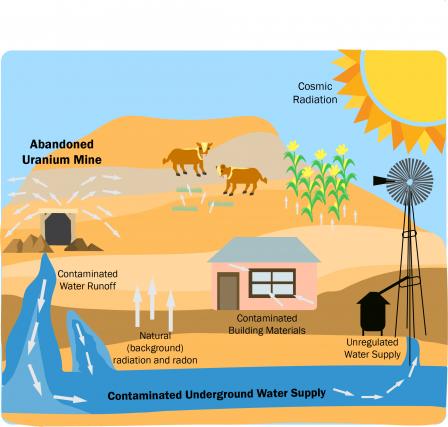RadTown Radiation Exposure Activity 4: Exposure Pathways
Radionuclides can travel through air and water, or be taken up (absorbed) by plants, which are eaten by animals like a food chain or web. In this activity, students are asked to think about the different ways we may be exposed to radiation through our environment. This activity is intended for middle and high school students.
- Objectives
- Next Generation Science Standards
- Materials and Resources
- Time
- Vocabulary
- Directions
- Common Core State Standards
Objectives
Students will:
- Identify sources of radiation exposure.
- Diagram exposure pathways.
- Assess the benefits and risks of radiation exposure.
Next Generation Science Standards
The concepts in this activity can be used to support the following science standards:
- PS4. Waves and Electromagnetic Radiation
- LS2. Matter and Energy in Organisms and Ecosystems
Materials and Resources
- Radiation Exposure: Teacher Background Information
- Vocabulary Materials
- Chalkboard, whiteboard, interactive whiteboard, computer and/or projector if needed for student presentations
- Student computers with access to the Internet and a printer (optional)
- Art supplies for students (e.g., paper or poster board, magazines, colored pencils and markers)
Time
45-60 minutes.
Vocabulary
- Alpha particles
- Beta particles
- Direct exposure
- Gamma rays
- Ingestion
- Inhalation
- Ionizing radiation
- Man-made radiation
- Natural (background) radiation
- Radiation
- Radiation exposure
- Radiation protection
- X-rays
Directions
- Start with a vocabulary activity if students are not familiar with radiation and the terms used in this activity, or provide students with the terms and definitions.
- Ask students how they might be exposed to radiation and the pathways through which radiation can enter their body. You can provide several examples such as radon, x-rays, and radiation sources contained in ionizing smoke detectors or tritium exit signs. The routes of exposure include direct or external exposure, inhalation and ingestion. X-rays are an example of direct exposure. Radon may be inhaled as a gas or ingested if it is in drinking water. Industrial radiation sources, like nuclear power plants, may be a source of all three exposure routes if released into the environment by accident.
- Direct students to:
- Work in small groups to identify a natural and a man-made ionizing radiation source.
- Determine the possible routes or pathways of exposure (i.e., direct or external exposure, inhalation and ingestion) for each radiation source, including exposure pathways for accidentally released sources.
- Diagram the exposure routes or pathways in the form of radiation webs or chains (similar to food webs or chains) using paper and art supplies, computers or an interactive whiteboard to display their diagrams. An example for contamination from an abandoned uranium mine. NOTE: If sharing the example with students, it may include terms with which students are not familiar. Helpful resources may include their textbooks or EPA's Radionuclides webpages.
- Discuss as a group or class whether the radiation sources or exposure pathways present a benefit (e.g., nuclear medical treatments), a risk (e.g., accidentally released, ingested or inhaled radiation sources) and/or if it is a natural occurrence (e.g., cosmic rays). If a source presents a risk and exposure can be limited, have students hypothesize and list possible methods that can limit one’s exposure and risk.
- Ask students or groups to share and describe their web or chain, listing the benefits, risks (limitations if applicable) and natural occurrences of the radiation sources.
- Conclude by asking students to:
- Describe interesting facts or findings they learned from the activity.
- Explain whether the activity changed their perceptions or fears about radiation exposure.
Common Core State Standards (CCSS)
The concepts in the Exposure Pathways activity align with the following standards:
- CCSS English Language Arts Standards for Literacy in History/Social Studies, Science, & Technical Subjects:
- CCSS.ELA-Literacy.SL.6-12.1 Comprehension and Collaboration
- CCSS.ELA-Literacy.RST.6-12.7 Integration of Knowledge and Ideas


